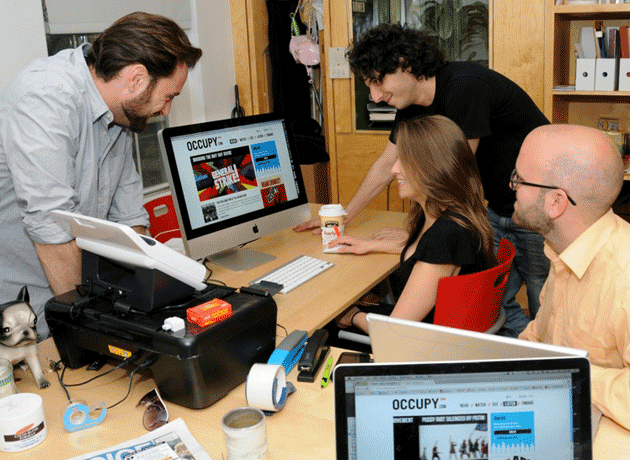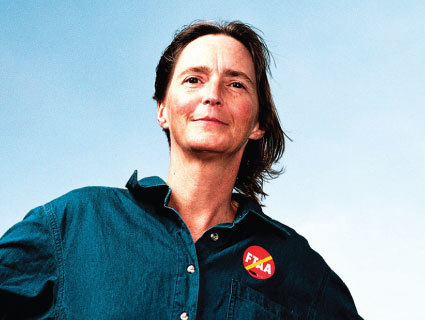 From left: Occupy.com cofounders Seth Adam Cohen and David Sauvage, manager Samantha Pastor, and social-media editor Justin Wedes. Photo by Alex Fradkin
From left: Occupy.com cofounders Seth Adam Cohen and David Sauvage, manager Samantha Pastor, and social-media editor Justin Wedes. Photo by Alex Fradkin
Call him Occupy’s Arianna Huffington.
New York filmmaker David Sauvage is cofounder of Occupy.com, a nonprofit multimedia and news-aggregation site that launches today with financial backing from Hollywood, lots of complicated internal politics, and a plan to become a must-read for a new generation of activists. “There is so little in the media that the vast majority of people engage with that is alive, or powerful, or truthful, or messy, or complicated, or real,” says Sauvage, 31, whose last project before joining Occupy Wall Street was a TV commercial for WSJ, the glossy magazine of the Wall Street Journal. “I would like to see the makers of content emerge as the shakers of the world.”
That might sound like a tall order, but Sauvage has already seen the movement reward his ambitions. In October, he made a slick promotional video about Occupy Wall Street, then raised $7,000 on a crowd-funding website to air it on several cable channels, including a segment of Fox News’ The O’Reilly Factor. The spot caught the attention of Larry Taubman, a 61-year-old film producer, * who wanted to work with Sauvage on other Occupy-themed videos.
“I’d been waiting for when that next generation was going to arise and basically reclaim their future,” says Taubman, who splits his time between a Seattle law practice and his Beverly Hills film production company, which has worked with celebrities such as Danny Glover and Morgan Freeman. At the time, Taubman was buying pizzas and raincoats for Occupy Seattle but was eager to do more.
Instead of another commercial, however, Sauvage pitched him on going in together to acquire Occupy.com. Taubman’s jaw dropped at the domain name’s asking price, but he eventually snatched it up for a large confidential sum and kicked in another $130,000 in seed money. “It was very clear that the Occupy movement needed a way in which it could speak for itself, and without having to do it through the lens of other media,” says Taubman, who has given Sauvage’s crew of six editors total control over the site’s content. “The reason that we are in existence is that we want to show the world who we are.”
I learned of the impending launch earlier this month courtesy of a public-relations firm that has also represented Dolce & Gabbana, Dona Karan, and Bergdorf Goodman. The following week, I met Sauvage and his partners at the Awareness Experiment, an event at New York’s über-hip Bowery Hotel that brought occupiers together with a crowd of supermodels, socialites, and celebrities including Sean Lennon, Penn Badgley of Gossip Girl, and Zoe Kravitz (daughter of Lenny and a star of X-Men First Class). The event felt far removed from the heady days of Zuccotti Park. But that was the point: Organizers wanted to expose Occupy to a different crowd.
Sauvage foresees Occupy.com performing similar kinds of outreach. While sites such as OccupyWallSt.org, NYCGA.net, and the soon-to-launch Occupy.net primarily speak to occupiers, Sauvage wants to target “the millions of people who are interested in the movement but haven’t been able yet to engage with it.”
Like the Huffington Post, Occupy.com will publish and link to stories, videos, music, and photography from across the internet, though it will put more emphasis on artsy and documentary-style content than news. Sauvage has organized the site by type of media (video, audio, text, etc.) as opposed to subject matter. “It feels flat to put these things into topics,” he says. For content, the editors have reached out to sympathetic filmmakers and photographers, citizen journalists, and media groups associated with dozens of occupations, including “Occupied” publications in cities from London to Los Angeles.
But can Occupy.com develop a significant following? On the day Occupy Wall Street was evicted from Zuccotti Park, 500,000 people visited OccupyWallSt.org to see what the movement was saying about itself. Sauvage believes that Occupy.com can attract similar numbers during Occupy’s forthcoming “American Spring” protests by offering a more accessible format and wider range of content. “When big events happen,” he says, “people will naturally gravitate towards Occupy.com.”
As with other attempts to broaden the movement, seasoned OWS activists view Occupy.com with a mixture of hope and skepticism. The site is not beholden to the General Assembly, the Occupy movement’s fractious consensus-based decision-making body. Some team members will earn “living stipends,” contributing to the perception that it is “professionalizing” the movement. And the ability to pick stories to feature gives the site’s editors some degree of de facto power. One early collaborator, the filmmaker Katie Davison, told me she parted ways with Occupy.com in part due to concerns that it was “concentrating too much power in the hands of the curators.” (She still counts herself as a supporter.) “Some are worried” that the site is too “top down,” notes a veteran OWS organizer who asked not to be named, “but are willing to give it a chance.”
Sauvage is keenly aware of the pushback and has worked for months to allay people’s concerns. He points out that he has been deeply involved in OWS since last fall, when he made a fundraising video for the website of the New York City General Assembly. His social media experts, Justin Wedes and Kira Annika, are behind the two of the movement’s most popular Twitter streams.
Michael Levitin, who is overseeing the site’s text-based content, is one of the cofounders of the Occupied Wall Street Journal, which is embraced by the movement despite being controlled by a tight-knit group of editors working out of a private apartment. “Having a group that is small enough and efficient enough to get things done kind of required an isolation from the time-consuming, consensus-based process that the rest of the movement was working with,” says Levitin, who has been a foreign correspondent for Newsweek and Forbes. “Obviously you put a thing like ‘dot com’ on something like ‘Occupy’ and it raises a lot of eyebrows,” he adds. “It raised mine. But I just saw the opportunities that it implied.”
“We want stories to reflect the particulars of a place while really coming across as universal to the issues that we are experiencing and sharing,” Levitin says. “The message is that we are all in this together.”
One of Occupy.com‘s debut stories, “Victory in Appalachia,” tells of former workers from West Virginia’s Century Aluminum Corporation who found themselves “an accidental part of the Occupy movement” when they set up an encampment to protest cuts in the company’s retirement benefits. An organizer tells reporter Jake Olzen: “We felt we could make a statement about the whole 99 percent and how corporate America and greed overtook us and put us in poverty.”
Though some of the writing and the layout is a bit rough around the edges, Sauvage wanted to launch the site in time for Occupy’s spring offensive. Eventually, he hopes to dispense with the curated approach in favor of a Reddit-style system that lets users play a more active role in selecting and promoting content. And that won’t be the only change. “The stuff that works,” Sauvage explains, “is the stuff that you couldn’t have predicted.”
Correction: The original version of this article stated that Taubman was African-American. He is white. Mother Jones regrets the error.
















